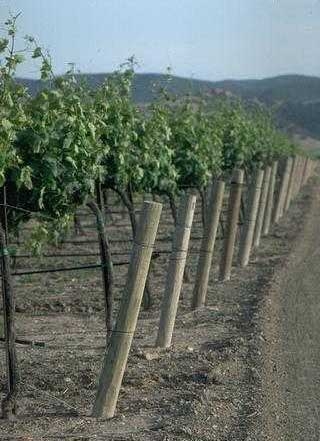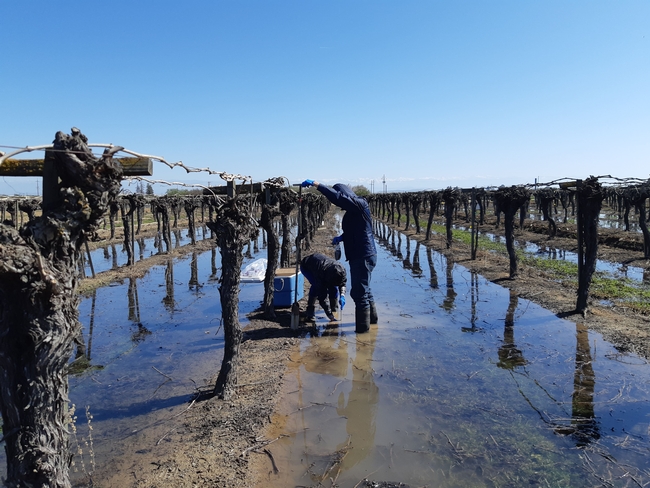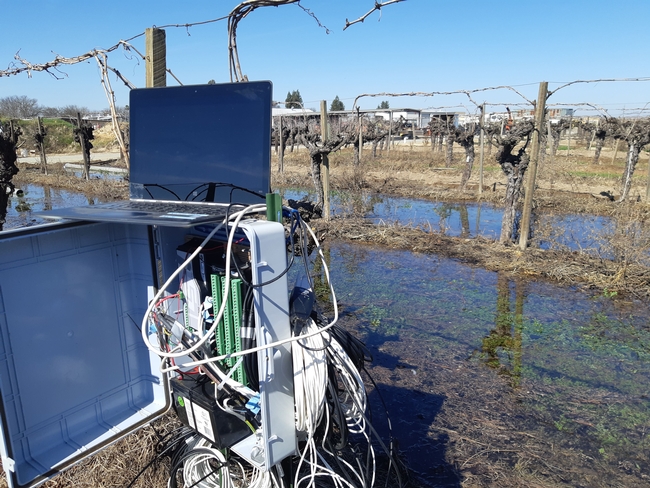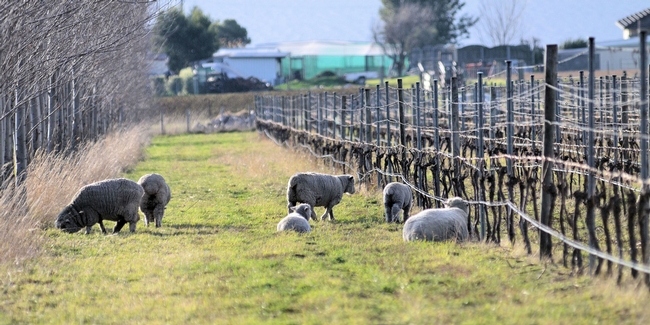Posts Tagged: vineyard
Study offers insights on reducing nitrate contamination from groundwater recharge
Light irrigation before flooding stimulates microbes to remove nitrates from soil
With California enduring record-breaking rain and snow and Gov. Gavin Newsom recently easing restrictions on groundwater recharge, interest in “managed aquifer recharge” has never been higher. This process – by which floodwater is routed to sites such as farm fields so that it percolates into the aquifer – holds great promise as a tool to replenish depleted groundwater stores across the state.
But one concern, in the agricultural context, is how recharge might push nitrates from fertilizer into the groundwater supply. Consumption of well water contaminated with nitrates has been linked to increased risk of cancers, birth defects and other health impacts.
“Many growers want to provide farmland to help recharge groundwater, but they don't want to contribute to nitrate contamination of the groundwater, and they need to know how on-farm recharge practices might affect their crops,” said Matthew Fidelibus, a University of California Cooperative Extension specialist in the UC Davis Department of Viticulture and Enology.
A recently published study by UC scientists sheds new light on how nitrates move through an agricultural recharge site and how growers might reduce potential leaching. Researchers analyzed data from two grapevine vineyards at Kearney Agricultural Research and Extension Center in Fresno County – one flooded for two weeks, and other for four.
Understanding initial nitrate levels crucial
A key factor in mitigating contamination is understanding how much nitrate is in the soil at the outset, said study author Helen Dahlke, a UC Davis hydrologist and leader of UC Agriculture and Natural Resources' strategic initiative on water. In areas with little precipitation and cropping systems that require greater amounts of synthetic fertilizer, the accumulation of residual nitrate – resulting from nitrogen in the fertilizer not taken up by the plants – can be quite high.
“The percentage of nitrates in some soils can really increase over the years, particularly if you have many dry years in a row where you don't have access to irrigation water or natural precipitation flushing some of those nitrates out of the soil,” Dahlke said.
While intense rains in recent weeks have helped dilute nitrate concentrations naturally, farmers looking to participate in recharge during the dry years ahead should consider flooding their fields with greater volumes of water.
“If you're doing this for the first time – on-farm recharge in the winter – check your residual soil nitrate levels because if they're very high, you should apply a lot of water in order to make sure that the residual nitrate is diluted down,” said Dahlke, who also added that growers should check their soil properties for suitability of recharge projects.
She recommended using, as a “good first approximation,” the online Soil Agricultural Groundwater Banking Index map, a project led by Toby O'Geen, a UC Cooperative Extension soil resource specialist.
Researchers looking at other ways to reduce nitrates
Even before flooding the fields for recharge, there are several practices that can lower initial nitrate levels and risk of leaching. Cover crops such as alfalfa and triticale, for example, can help take up residual nitrates that accumulate from fertilizing a main crop over time.
Dahlke and Fidelibus – a co-author of the San Joaquin Valley vineyard study – both pointed to pre-flooding irrigation that encourages denitrification, a process in which soil microbes transform nitrates into gaseous forms of nitrogen.
“Those denitrifying microbes need to be stimulated to do the work,” said Dahlke. “What we have found is that if you do a little bit of irrigation before you start the flooding, increasing the soil moisture can get those microbes started and they can take out more nitrate from the soil.”
The timing and quantity of fertilizer applications are also major factors in reducing leaching. Although more growers are following high-frequency, low-concentration practices to maximize uptake by crops, Dahlke said there needs to be more emphasis on incorporating nitrogen transformation processes – such as denitrification – in the nutrient management guidelines that farmers follow.
“Implementing thoughtful nutrient management plans will play a particularly important role in participating farms,” Fidelibus added.
A more holistic view of groundwater recharge
In short, choices made during the growing season can affect those in the winter recharge season – and vice versa. For example, applying compost or other organic amendments to soil can give microbes the “fuel” they need for sustained denitrification.
“What we have found is that our denitrifying bacteria often run out of steam because they don't have enough carbon to do the work,” Dahlke said. “Like us, microbes need energy to do the work, and for microbes this energy comes from soil carbon.”
Then, adding moisture via recharge to that field with high organic content can stimulate mineralization and nitrification, processes in which microbes transform the organic nitrogen into ammonium – and subsequently nitrates – that the plants can then take up. Those naturally occurring nitrates would thus reduce the need for the grower to apply synthetic fertilizer.
“The winter on-farm recharge experiments have shown that altering the moisture regime in the winter has consequences for the nitrogen budget in the summer growing season,” Dahlke explained. “Theoretically, what we need to be doing is better integrating both seasons by keeping an eye on the soil-nitrogen balance across the whole year so that we can ensure, at the end of the growing season, the residual nitrate in the soil is minimized.”
The study, published in the journal Science of The Total Environment, was part of the post-doctoral work of former UC Davis researcher Elad Levintal. In addition to Fidelibus and Dahlke, other authors are Laibin Huang, Cristina Prieto García, Adolfo Coyotl, William Horwath and Jorge Rodrigues, all in the Department of Land, Air and Water Resources at UC Davis.
On the topic of vineyard nutrient management, farmers want to know about sheep
The UC Sustainable Agriculture Research and Education Program is working to build an online community for growers facing challenges and trying innovative approaches to how they manage nutrients on the farm. With the help of FarmsReach and Sustainable Conservation, we've been working to build up an online group based on nutrient management to discuss a wide array of practices. For two weeks in January, we hosted a discussion on nutrient management for vineyards, particularly in times of drought.
In a recent Capital Public Radio story on winemakers struggling with groundwater shortages this year, winemaker Chris Leamy said “the drought has helped to spur change and innovation.” When business as usual is not an option, farmers get creative. Through discussion, informational videos, and a tool kit of resources, farmers and UC advisors shared some of the creative ways that growers are adapting to water limitations and building healthy soil in their vineyards.
One discussion to rise to the surface throughout was the use of animals in vineyard systems. Farmers with experience running animals through their vineyards chimed in with valuable insights.
Some thoughts repeated by several growers were:
- Short breeds like babydoll sheep and tall cordons on vines make sheep less able to graze on the canopy. Some growers use electrified deterrents running parallel to the trellis to allow sheep to stay in the vineyard into the summer with no leaf damage. Growers who kept sheep in vineyards year round described eliminating mowing completely.
- Drip lines need to be tall enough to be out of reach from sheep.
- Move sheep frequently to prevent soil compaction.
- One grower runs chickens through the vineyard at the end of the season, but says to avoid the practice if shoot growth has been too vigorous — the added nutrients from the chickens may give vines an unwanted boost in the spring.
- Growers who use sheep in their vineyards describe significant nutrient inputs from sheep, some to the point of eliminating other fertilizers altogether.
You can follow more of the conversation here. The group of participants is growing (94 strong now!) and we'll be hosting future discussions on different topics. This project is hosted by UC SAREP as part of the Solution Center for Nutrient Management. You can join our mailing list to stay up-to-date with our activities, online discussions, and updates to our website.
Winemaking venture initiated by former UCCE advisor
Former Fresno County UC Cooperative Extension farm advisor, Lowell Zelinski, and his wife are launching a new luxury winemaking course in Paso Robles to operate in conjunction with their agricultural management business, according to a story in the Santa Maria Times.The Zelinskis began working with Central Coast vineyards in 2003; a few years later they began making wine from vines they were managing, a process documented by Becky Zelinski, an aspiring photographer.
Their friends were envious, the newspaper reported. "The Zelinskis then wondered if their friends’ interest could translate into a do-it-yourself winemaking business," wrote reporter Laurie Jervis.
In 2008, 14 friends and friends of friends spent a weekend in a cabernet sauvignon vineyard, picking and de-stemming the grapes by hand.
In 2009, the couple offered three weekend sessions on three different varietals. The weekends included meals prepared by a local chef to complement the varietal under study.
“These are the vineyards that we have relationships with all year," Mrs. Zelinski was quoted in the paper. "Many of the people (involved in those vineyards) are excited about our concept and want to help."

vineyard




